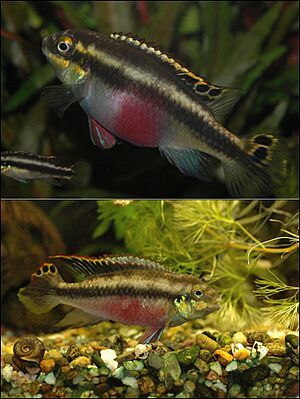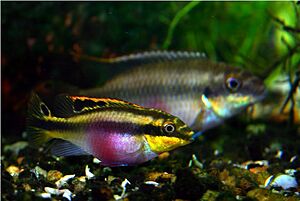Pelvicachromis pulcher facts for kids
Quick facts for kids Pelvicachromis pulcher |
|
|---|---|
 |
|
| Top: Female P. pulcher bottom: Male P. pulcher |
|
| Conservation status | |
| Scientific classification | |
| Synonyms | |
|
The Pelvicachromis pulcher is a type of freshwater fish. It belongs to the cichlid family. This fish naturally lives in Nigeria and Cameroon.
It is a very popular fish for aquariums. Most people know it as the kribensis. It also has other fun names like krib, red krib, rainbow krib, rainbow cichlid, and purple cichlid.
Contents
About the Kribensis
Wild male P. pulcher fish can grow up to about 12.5 centimeters (5 inches) long. They can weigh around 9.5 grams. Females are a bit smaller and have a deeper body. They grow to about 8.1 centimeters (3.2 inches) long and weigh up to 9.4 grams.
Both male and female kribensis have a dark stripe. This stripe goes from their tail fin to their mouth. They also have pink or red bellies. The color of their bellies gets brighter when they are ready to mate. Their top and tail fins might have gold-ringed eye-like spots. Males can show different colors in some groups. Young fish look similar until they are about six months old.
Where Kribensis Live
Pelvicachromis pulcher fish come from southern Nigeria and coastal areas of Cameroon. They like warm water, usually between 24 and 26 degrees Celsius (75–79°F). The water is also slightly acidic to neutral and soft.
You can also find groups of P. pulcher in Hawaii, USA. They got there because of the pet fish trade.
These fish live in both slow and fast-moving water. But they always need places with lots of plants. They use these plants for shelter. Other fish that live with kribensis include other types of cichlids.
Bigger fish like the Hepsetus odoe and the Nile perch sometimes hunt kribensis. In their natural home, kribensis dig and hide in caves under plants. They also use these caves for breeding. Not all kribensis claim a territory. Many live together in large groups without breeding.
What Kribensis Eat
Some aquarium books say that kribensis eat worms, crustaceans, and insects. However, studies of wild kribensis show something different.
A study in 1985 looked at the stomachs of 161 wild kribensis. It found that they mostly eat tiny diatoms, green algae, and pieces of other plants. They also eat blue-green algae. They do eat some Invertebrates, but these are not their main food.
Reproduction and Life Cycle
Male and female P. pulcher fish look different. This is called sexual dimorphism. Males have pointed fins on their belly, back, and bottom. Females have more rounded fins. Males are also bigger. They do not have the gold shine on their back fin that females do. Their tail fin is also longer and spade-shaped.
Even though some books say they mate in pairs, it's common for one male to have several female partners in the wild. These fish are shy cave breeders. This means they lay their eggs inside hidden caves. In the wild, they breed in holes they dig under water plants. In tanks, they will use artificial caves.
The eggs are sticky and are often laid in rows of about 10. A female can lay between 40 and 100 eggs. Both the male and female fish take care of their babies. This care usually lasts for 21 to 28 days. They guard, herd, and feed their young. The female usually takes care of the babies more. The male mainly defends their territory.
The number of female babies compared to male babies changes with the water's pH level. A higher pH means more female babies. Male kribensis can have different colors. For example, red males from one area were found to be more aggressive. They also had more female partners than yellow males from the same place. These fish can also work together to defend their territory.
Kribensis in Aquariums
The Pelvicachromis pulcher is a very popular cichlid fish for aquariums.
Special Breeding
People have bred an albino version of this fish for aquariums. Unlike typical albinism, this trait is not passed down in the usual way. It's an incompletely dominant trait. This means that even albino kribensis can still have red and yellow colors. They might also have dark spots on their back and tail fins.
See also
- List of freshwater aquarium fish species
- Pelvicachromis taeniatus





